 |
|
|||
 |
 |
|||
RINKER ON COLLECTIBLES — Column #1701 Copyright © Harry Rinker, LLC 2019 Questions
and Answers
QUESTION: In going through some items I inherited through my family, I found a silver etrog box (or esrog, as I knew it from my Sunday School days). The coffin shaped box has an elaborate relief border on the top and bottom on the body and a stepped dome lid with a relief foliate design. Although I have not translated the Hebrew engraved on it, there is a 1926 date beneath the letting on the left side of the front. The box has several stamp markings on the bottom; (1) a circle surrounding an asterisk-like mark, (2) an oval inside of which is “FRAGET / N / PLAQUE”, (3) “3338,’ and (4) “XIX 71.” What is the history and value of my etrog box? – JF, Houston, TX, Email Question 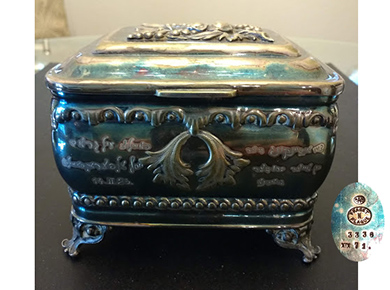
ANSWER: An etrog is a yellow citron or citrus medica, one of the four spices along with aravah, hadass, and lulav used by Jews during the week-long holiday of Sukkot (the harvest Festival of Tabernacles). Etrogim has been grown in Israel since the time of the Second Temple. Citron pollen was found in excavations in the Ramat Rachel site. Etrog is traditionally wrapped in silky flax fibers and stored in a box, usually made of silver. When not used during Sukkot, the fruit is given to a pregnant woman to ensure an easy childbirth. Cloves are stuck in the fruit for use as besamin at the Havdalah ceremony after Shabbat. Etrog is occasionally used to make jam or liquor. The etrog container is of relatively recent origin. It is made from silver, plate, or wood. In Poland, it was customary for a groom to present an etrog box as a wedding gift. to his bride. Was someone in your family married in 1926? Could this have possibly be a wedding present? You need to have the Hebrew translated. Dr. David N. Nikogosyan’s article “Marks of European Silver Plate: XII: Fraget, Russia/Poland” on the Association of Small Collectors of Antique Silver (ASCAS)’s website [http://www.ascasonline.org/windowAGOS99.html] provides detailed information on Jozel Fraget, a Warsaw jewelry company that was renowned for its pioneering work in galvanic silver plate production. The firm was founded in 1823. When Jozel died in 1867, his son Julian became manager of the firm. His daughter Maria Swiatopelk-Mirska (1841-1938) became head of the firm when her father died tragically in 1906. The Nikogosyan article contains illustrations of the firm’s mark. The mark on your piece is similar to the 1896 to 1914 mark with the exception of the lack of the Russian Empire coat of arms. This suggests the piece was made after Poland became independent once again following World War I. What looks like an asterisk is actually the coat of arms of the coppersmiths’ and bronze-smiths’ corporation. Since your etrog box is silver plated, it has no melt value. Polish silver plated etrog boxes from the early part of the 20th century sell through in the secondary market between $70.00 and $90.00. eBay sellers ask double this, but few boxes are being purchased at these prices. Of course, if the piece’s history involves a member of your family, its sentimental value is far in excess of its secondary market retail value. QUESTION: My brother received a Roy Roger’s buckskin jacket with tassels for his eighth birthday. He LOVED it. When we were outside playing, a mean, older neighbor boy ran up to my brother and started pulling the tassels off the back. My brother and I were horrified and ran back home crying. Although my brother still wore (had to) the jacket until he grew out of it, it was a constant reminder of his bad experience. My brother is now 65 and has financial burdens due to health bills. I have the jacket (size 8 or 10) and would like to sell it and give him the money. How much can I get? – DS, Festus, MO, Email Question 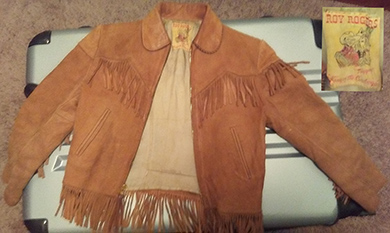
ANSWER: There are no longer any “Happy Trails for Roy Rogers (born Leonard Franklin Slye) (1911-1998) and Dale Evans (1912-2001) memorabilia. Roy Rogers, touted as “The King of the Cowboys” appeared in more than 100 films and numerous radio and television episodes of “The Roy Rogers Show.” His television show aired from 1951 to 1957. The Roy Rogers Museum collection, which had been moved from Dale and Roy’s museum in Ventura, California to Branson, Missouri, was sold in July 2010. The sale was a sad ending to a cowboy hero whose career spanned over half a century. The generations who grew up with the B movie cowboys and early television cowboys have reached the age where they have stopped collecting or already have gone on their last roundup. The result is a collapse in the secondary market pricing for their memorabilia. It makes no difference if the memorabilia is from Hopalong Cassidy, Gene Autry, the Lone Ranger, or television shows ranging from the Legend of Wyatt Earp to Gunsmoke to Bonanza. The long collecting trail drive is nearing the railhead for an eventual trip into obscurity. Further, as collectors of this material die off and their children and grandchildren attempt to sell it, they are flooding the market. Supply exceeds demand, even for scare items. WorthPoint.com contains several listings for a Roy Rogers buckskin jacket. A small, well-worn size 4 jacket sold for $22.50 in March 2019. A pair of jackets sold for $29.88 in February 2017. A size 10 jacket brought $10.00 in December 2016. A retail secondary market value for your jacket is between $12.50 and $17.50. Even at these prices, it will be a hard sell because it is damaged. I wish I had better news. 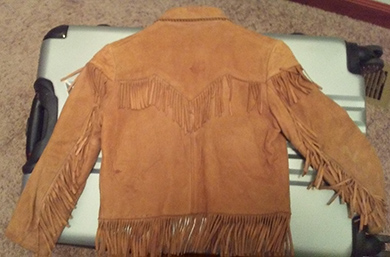
QUESTION: I have two cast iron pots that have been passed down through my wife’s family. Each is marked on the bottom in block letters: “SIDNEY / HOLLOWWARE / SIDNEY / O / 8.” Just wondering if you might know something about them and if they have any value other than sentimental. DR, Sidney, OH, Email Question ANSWER: You own 8-quart stock pots. Other cast iron companies made similar stock pots. Philip Smith, a Pennsylvania native, moved to Sidney, Ohio, in 1859. He learned the art of casting while working at Thompson, McGregor, and Callahan. Philip and his brother founded P. Smith & Company. Philip eventually bought out his brother. P. Smith and Company did not make cookware. It made bells for churches and schools. A fire in the 1860s destroyed the factory. It was not insured. The company struggled to survive. In the 1870s, P. Smith bought a plough company. Kettles were added to the company product line. Cast iron hollowware was first made in 1886. These early pieces were marked with a script “Sidney” and did not contain the word “Hollowware.” P. Smith and Company became the Sidney Hollowware Company sometime in the late 1880s or early 1890s. In 1897, Wagner Ware bought the Sidney Hollowware Company. Wagner continued to market product under the Sidney Hollowware brands. The Sidney logo now used block printing. Your 8-quart stock pots most likely were made during the period when the company was owned by Wagner Ware. P. Smith bought back the Sidney Hollowware Company from Wagner in 1903. He did not restart the factory and retired in 1907. There appears to be little demand for your Sidney stock pots. A check of the listings on WorthPoint.com suggests a secondary market value around $35.00. Modern “cooking with cast iron” cookbooks do not emphasize the use of stock pots. Finally, the stock pots you own are not able to be used on a modern stove—the three small legs on the bottom prevent the pot from sitting flat on a stove top. 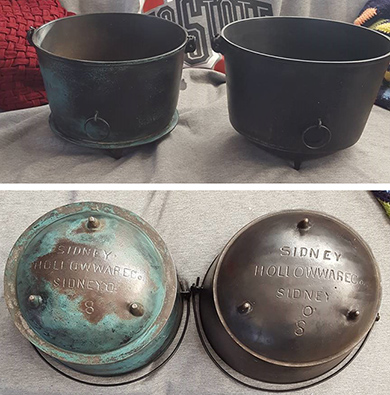
QUESTION: I have an original vintage USMC lighter with the EGA emblem. The lighter is marked on the bottom: “CREST CRAFT / MADE IN U.S.A.” I think there are only two existing. What is its value? -- RB, Email Question ANSWER: Think again. The survival rate of these lighters is much higher. WorthPoint.com has a listing for a USMC Crest Craft lighter that sold in October 2017 for $20.00. Other examples sold between $12.00 and $30.00. A reasonable secondary market retail value for a working lighter in fine or better condition is between $17.00 and $22.50. 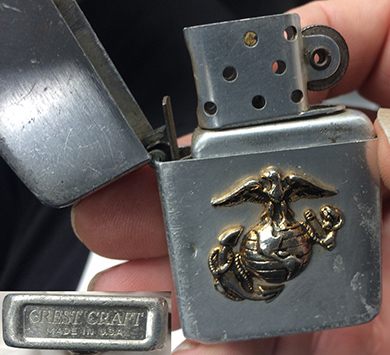
Harry L. Rinker welcomes questions from readers about
collectibles, those mass-produced items from the twentieth and twenty-first centuries.
Selected letters will be answered in this column.
Harry cannot provide personal answers.
Photos and other material submitted cannot be
returned.
Send your questions to: Rinker on Collectibles, 5955 Mill
Point Court SE, Kentwood, MI 49512.
You also can e-mail your questions to
harrylrinker@aol.com.
Only e-mails containing a full name and mailing address
will be considered.
|
||||